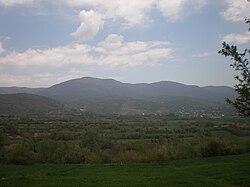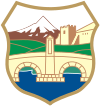Skopska Crna Gora
| Skopska Crna Gora | |
|---|---|
| Macedonian and Serbian Cyrillic: Скопска Црна Гора, Skopska Crna Gora Albanian: Mali i Zi i Shkupit / Malet e Karadakut Turkish: Karadağ | |
 | |
| Highest point | |
| Peak | Ramno |
| Elevation | 1,651 m (5,417 ft) |
| Coordinates | 42°11′24″N 21°26′24″E / 42.19000°N 21.44000°E |
| Naming | |
| Native name | Скопска Црна Гора (Macedonian) |
| Geography | |
Location of the mountain within North Macedonia | |
| Location | North Macedonia, Kosovo and Serbia |

Skopska Crna Gora (Macedonian and Serbian Cyrillic: Скопска Црна Гора, pronounced [skôpskaː tsr̩̂ːnaː ɡǒra]; Albanian: Mali i Zi i Shkupit), often called simply Crna Gora (Macedonian and Serbian Cyrillic: Црна Гора; Albanian: Mali i Zi) or Karadak (from earlier Turkish: Karadağ; meaning "Black Mountain"), is a mountain range and ethnographic region in North Macedonia, Kosovo[a] and Serbia. It lies between the cities of Kaçanik in the West, Skopje in the South, Kumanovo and Preševo in the East and Gjilan in the North. It is essentially a continuation of the Šar Mountains and is separated by the gorge of Kaçanik. The highest peak is Ramno (1,651 m (5,417 ft)) in Macedonia.[1] The largest town on the mountain is Kučevište in North Macedonia.[1][2]
Geography

The Skopska Crna Gora stretches from the Gorge of Kaçanik or more specifically the Lepenac river to the west - to the Preševska Moravica and the Gorge of Končulj in the east, the Binačka Morava river to the north and to Aračinovo in the south. The relief structure is fragmented due to the rivers of the region which descend from high points and carry eroded material within their waters; additionally, the geological composition of the region is complicated as there are new sediments in the west, Mesozoic layers in the middle and old Palaeozoic layers in the east. The most important rivers are Letnica, Golemareka, Karadak, Pasjani, Lashtica, and Llapushnica among others; they all empty into the Binačka Morava river. 31% of the region consists of arable land, whereas 11% consists of pastures and meadows. Due to the lack of nutrition available, the keeping of livestock is limited. The Skopska Crna Gora consists of many high mountain peaks ranging from 700-1,650m; some of the noteworthy mountains include Maja e Kopilaqës (Kopilaq Peak, 1,490m), Maja e Zeza (Black Peak, 1,219m) and Maja Topan (1,178m, Topan Peak). The mountains of Karadak cover around 389km2 and consist of around 50,000 inhabitants, with a density of about 120 per km2.[3]
Municipalities that lie in the region include:
Kosovo[a]:
Kaçanik, Viti, Elez Han, Gjilan, Ranilug, Parteš, Klokot
Serbia:
North Macedonia:
Čučer-Sandevo, Lipkovo, Aračinovo, Butel, Gazi Baba
History
Middle Ages
The first mention of the region dates back to the second half of the 13th century, when the Bulgarian Tsar Constantine Tih bequeathed the villages of this area to his endowment. Skopska Crna Gora is mentioned again under its name in 1300 in the chrysostom of King Milutin of Serbia in the church of St. George in Banjane, Skopje.
After the conquest of the region, the Ottomans translated the name into Karadag (Turkish:Karadağ -"Black Mountain"), which is why the term is still used by Albanians and Macedonians to describe the region.[4]
Ottoman Times
Following the Ottoman Takeover of the region, Albanian Clans (vllazni) setteled in the region, thus around 8-10% of the Albanian population belong to the Berisha tribe,[5] while Descendants of the Krasniqi tribe setteled in the villages of Gošince, Slupčane, Alaševce and Runica.[6] There are also members of the Mirdita and Sopi tribes which setteled in the region.
Following Tanzimat reforms in 1839 and the arresting and liquidation of the local Albanophone pashas, Albanians from Karadak and Sharr, led by Dervish Cara and local Albanophone pashas,[7] began revolting in the Town of Haraçina in the Karadak region. In January 1844 the Highlanders from Karadak and Sharr captured and liberated Gostivar and Kalkandelen. In February 1844 the rebels attacked and captured the whole Karadak region, Üsküb, Kumanova, Preševo, Bujanovac, Vranje, Leskovac and other territories now in Serbia,[8] after which they created a National Council led by Dervish Cara, who was appointed to be the supreme body of the newly created administration in the liberated territories. From there on the Revolt began to spread in all Albanian lands, but was ultimately suppressed by an Ottoman Army led by Hayredin Pasha in summer 1844.
During the mid 1800's, ethnic Albanians of the Catholic rite were expelled by Ottoman authorities in events that came to be known as the Expulsion of Karadak.[9][10]
In the Albanian revolt of 1910, Albanian freedom fighters from Karadak under the command of Idriz Seferi rebelled against the Ottoman Empire and managed to defeat them in the Battle of Kaçanik.[11][12] 2 years later in 1912, Albanians from Karadak under Idriz Seferi again rebelled with other Albanians against the Ottoman Authorities and managed to capture Skopje, which was the capital of the Kosovo Vilayet.[13][14]
Modern history
The region became part of the Kingdom of Serbia after the First Balkan War. Following this the region became a battleground between the Serbian forces supported by Chetniks and Albanian Kachaks under Idriz Seferi and Ajet Sopi Bllata as well as the Macedonian IMRO insurgents.[15][16] The region was occupied by the Kingdom of Bulgaria during the First World War and became part of the newly established Kingdom of Serbs, Croats and Slovenes after it ended.
During the Interwar period many Serb colonizers setteled in the region[17][18]
After the Invasion of Yugoslavia in 1941 the region was given to the Kingdom of Bulgaria, which resulted in Albanian resistance led by Mulla Idriz Gjilani.[19][20] The Rebellion of Mulla Idriz Gjilani was quelled by Bulgaria and the Yugoslav partisan forces after the Stratsin–Kumanovo and Kosovo Operation.
From 1999 to 2001, during the Insurgency in the Presevo Valley and the Insurgency in Macedonia the Serbian and Macedonian parts of the region became major strongholds of the Albanian seperatist organizations NLA and LAPMB and a stronghold of Albanian nationalism, thus the region saw many armed conflicts against the security forces of FR Yugoslavia and the Republic of Macedonia. Low intensity skirmishes continued in these parts of the region such as the Gošince attack and Kumanovo attack in 2015.
Culture
The Albanians of Karadak have a dialect of their own, which in itself is a north-eastern extremity of central Gheg Albanian. The dialect borders on the verge of north-eastern Gheg Albanian.[21]
The Macedonian population of the region speaks the Skopska Crna Gora dialect of Macedonian.
Notable people
- Idriz Seferi, Albanian patriot and freedom fighter
- Agim Ramadani, Albanian commander of the KLA
- Njazi Azemi, Albanian commander of the KLA and UÇPMB
- Ismet Jashari, Albanian commander of the KLA
- Xhezair Shaqiri, Albanian commander of the KLA and NLA
- Mulla Idriz Gjilan, Albanian Mullah and freedom fighter
- Sulë Hotla, Albanian Ballist commander
- Lavdrim Muhaxheri, Albanian terrorist
- Toma Raspasani, Albanian Catholic priest and freedom fighter
- Johan Tarčulovski, soldier and politician
- Triumf Riza, Albanian policeman
- Daut Dauti, Albanian lawyer and journalist
- Shemsi Beqiri, Albanian kickboxer and World champion
- Petar Mandzhukov, revolutionary and anarchist
- Nathanael of Ohrid, cleric, writer, and revolutionary
- Riza Halimi, Albanian politician
- Marko Sopi, Albanian Catholic prelate
- Ali Aliu, Albanian activist
- Limon Staneci, Albanian politician and journalist
- Xherdan Shaqiri, Swiss footballer of Albanian origin
- Nijazi Ramadani, Albanian poet
- Shaban Sejdiu, Macedonian-Albanian wrestler
- Shqiprim Arifi, Mayor of Preševo
See also
References and notes
- Notes
- References
- ^ a b Мала енциклопедија Просвета [Little Encyclopedia of Prosveta] (in Serbo-Croatian). Belgrade: Prosveta. 1969. p. 589.
- ^ Elsie, Robert (2011). Historical dictionary of Kosovo (2nd ed.). Lanham, Md.: Scarecrow Press. p. 152. ISBN 978-0-8108-7483-1.
- ^ Ramadani, Nijazi (23 February 2014). Shtegtime ne histori (Monografia për kokajt 1842-2012). pp. 1–2.
- ^ С. Томић, Скопска Црна Гора, Српски етнолошки зборник 3, Београд 1905, 409—417.
- ^ "Berisha, djepi iliro-arbnor i Alpeve shqiptare". Gazeta Dita. Retrieved 2022-05-25.
- ^ Naučno društvo Bosne i Hercegovine: Odjeljenje istorisko-filoloških nauka. Vol. 26. 1965. p. 199.
Arbanasa fisa Krasnića ima u selima: Gošnicu, Slupćanu, Alaševcu, Ruđincu.
- ^ La Question Nationale En Europe Du Sud-Est: Genese, Emergence Et Développement de L'Identite Nationale Albanaise Au Kosovo Et En Macedoine Author Bashkim Iseni Publisher Peter Lang, 2008 ISBN 3-03911-320-8, ISBN 978-3-03911-320-0 p.174
- ^ Albanische Geschichte: Stand und Perspektiven der Forschung Volume 140 of Südosteuropäische Arbeiten Authors Oliver Jens Schmitt, Eva Anne Frantz Editors Oliver Jens Schmitt, Eva Anne Frantz Publisher Oldenbourg Wissenschaftsverlag, 2009 ISBN 3-486-58980-6, ISBN 978-3-486-58980-1 p. 168
- ^ Kott, Marilyn (2016). Catholic Kosovo: A Visitor's Guide to Her People, Churches, Historical Sites, and Her 1,900 Year Journey. ISBN 9781483435213.
- ^ "NË STUBLLAVAQË GJURMËVE TË MARTIRËVE TË KARADAKUT". www.drita.info. 14 March 2016.
- ^ Elsie 2012, p. 403
- ^ Gawrych 2006, p. 177.
- ^ Pearsons 2004, p. 24
- ^ Skendi 1967, p. 436.
- ^ https://upload.wikimedia.org/wikibooks/sq/a/a9/Monografia-komplet-te-gjitha-kapitujt-nga-I--deri-IX.pdf [bare URL PDF]
- ^ Trotsky 1980, p. 117
- ^ Clark, Howard (2000). Civil resistance in Kosovo. Pluto Press. p. 10. ISBN 9780745315690.
- ^ Qirezi 2017, p. 54
- ^ Elsie, Robert (2013). A Biographical Dictionary of Albanian History. Londër: I.B.Tauris. p. 172. ISBN 9781780764313.
- ^ Elsie, Robert (2010-11-15). Historical Dictionary of Kosovo. Scarecrow Press. ISBN 978-0-8108-7483-1.
- ^ Hamiti, Asllan (2011). "THE SPECIALTY OF PHONETIC-PHONOLOGY IN THE SPOKEN OF KARADAK, SHKUP" (PDF). Journal of Institute Alb-Shkenca. 4: 672.
Sources
- "Skopska Crna Gora", Srpski etnografski zbornik, VI, Belgrade, 1905



